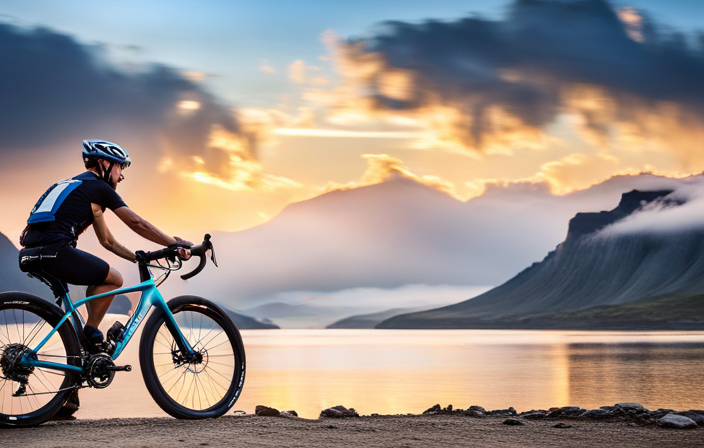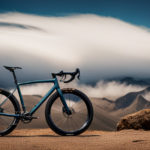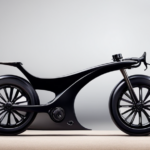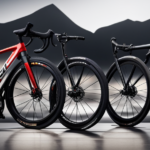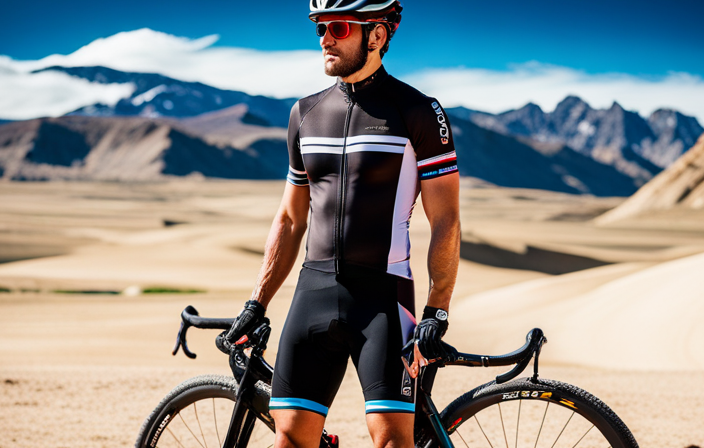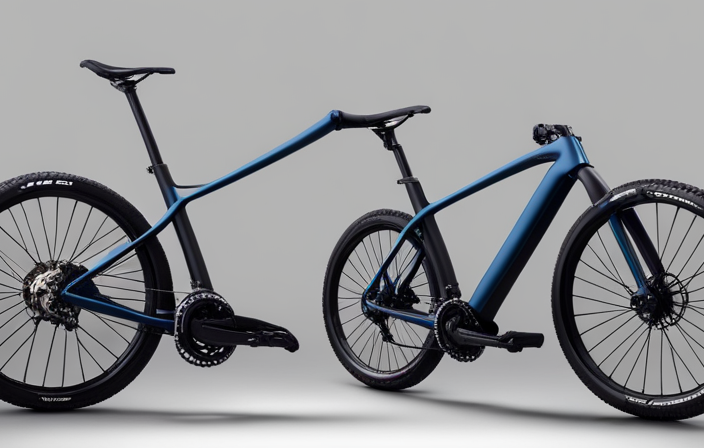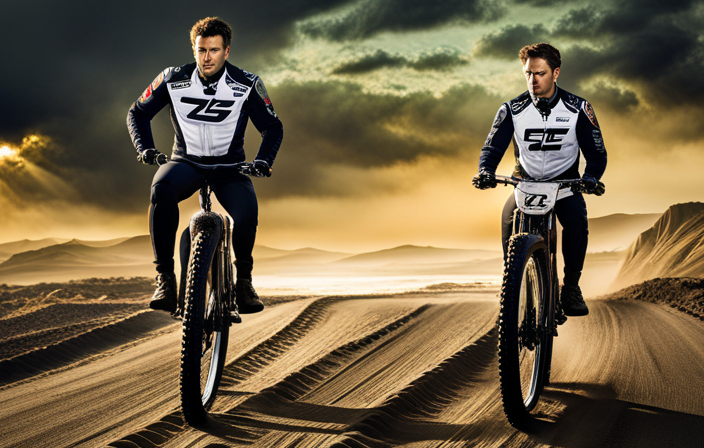Imagine yourself flying down a rough trail on your gravel bike, with the wind whipping past you as you overcome each challenge.
Now, imagine gripping the handlebars and experiencing the perfect balance of control and comfort.
This is made possible by one simple yet ingenious design feature: flared handlebars.
In this article, we will explore why gravel bike handlebars are flared, their benefits for both recreational riders and competitive cyclists, and what the future holds for handlebar designs in the world of cycling.
Get ready to embrace the flare!
Key Takeaways
- Flared handlebars were developed as a response to the rise in popularity of gravel biking.
- Flared handlebars offer improved stability, control, and handling on rough terrains.
- They provide a wider grip for better handling and increased comfort and ergonomics.
- Flared handlebars are versatile and suitable for various riding disciplines such as gravel riding, bikepacking, touring, cyclocross, and adventure racing.
The History of Handlebar Designs
If you’re curious about the history of handlebar designs, you’ll find that gravel bike handlebars are flared for a specific reason. The evolution of handlebar shapes can be traced back to the early days of cycling when bicycles were first introduced in the late 19th century.
Initially, handlebars were made from materials such as wood and steel, which provided limited comfort and control for riders. As technology advanced, new materials like aluminum and carbon fiber were introduced, allowing for lighter and stiffer handlebars.
Over time, there was a growing understanding of the importance of ergonomics in cycling. This led to the development of various handlebar shapes to accommodate different riding styles and preferences. From classic drop bars to aerodynamic bullhorns, each design served a specific purpose.
In recent years, with the rise of gravel biking, there has been a shift towards flared handlebars. These wide flare bars provide better stability and control when riding on rough terrain or during off-road adventures. The flared shape allows for more leverage while maintaining a comfortable hand position on longer rides.
With this historical context in mind, it’s clear that gravel bike handlebars are not just a trendy innovation but rather an evolution in response to changing cycling needs.
The Rise of Gravel Biking
When you’re exploring the rise of gravel biking, it’s important to consider the unique design features of handlebars. Gravel biking has gained popularity in recent years due to its versatility and ability to tackle a wide range of terrains. As a result, bike manufacturers have developed specific accessories and components tailored for this growing discipline.
Gravel bike races have become increasingly popular, attracting cyclists who seek adventure and challenge. To meet the demands of these races, handlebar designs have evolved to enhance control and stability on rough terrain. One notable feature is the flared shape of gravel bike handlebars. The flare refers to the outward angle from the center clamp area towards the ends of the bars.
This flared design provides several benefits for gravel biking:
- Increased leverage: The wider grip allows for greater leverage when navigating technical sections or powering through loose surfaces.
- Improved handling: The flare provides additional stability by widening your hand position, giving you better control over your bike.
With these advantages in mind, it’s clear why flared handlebars have become a popular choice among gravel bikers. In the next section, we will explore the benefits of flared handlebars in more detail.
The Benefits of Flared Handlebars
Flared handlebars offer several key benefits for gravel biking.
Firstly, they provide improved stability and control by offering a wider grip, allowing for better handling in challenging terrain. This can be particularly useful when navigating corners or descents at high speeds.
Secondly, the flared shape of the handlebars increases comfort and ergonomics by providing a more natural hand position, reducing strain on the wrists and shoulders during long rides.
Lastly, the wider grip also enhances handling on rough terrains by providing additional leverage and control over the bike, allowing riders to confidently tackle uneven surfaces with ease.
Improved Stability and Control
Gravel bike handlebars with a flared design provide better stability and control. Here are four key reasons why:
-
Improved handling: The flared shape of these handlebars allows for a wider grip, giving riders more leverage and control over their bike. This is especially important when navigating rough terrain or making sharp turns.
-
Increased stability: The wider stance offered by flared handlebars helps distribute the rider’s weight more evenly across the bike, enhancing overall stability. This is particularly beneficial when riding at higher speeds or on unstable surfaces.
-
Better control off-road: Flared handlebars offer greater maneuverability, allowing riders to easily negotiate obstacles like rocks, roots, and uneven surfaces. The increased control translates to a safer and more enjoyable off-road biking experience.
-
Enhanced confidence: With improved handling and increased stability comes a boost in confidence for riders tackling challenging terrains. Flared handlebars inspire trust in the bike’s capabilities, enabling riders to push their limits and explore new adventures.
Transitioning into the next section about increased comfort and ergonomics, it’s worth noting that these benefits also contribute to a more comfortable ride overall.
Increased Comfort and Ergonomics
The increased comfort and ergonomics of these handlebars make long rides much more enjoyable. The flared design allows for a wider grip, which reduces strain on the wrists and shoulders. This wider grip also provides increased stability, allowing riders to confidently navigate through rough terrains. Moreover, the ergonomic shape of the handlebars promotes a natural hand position, preventing numbness and discomfort during extended rides. To illustrate the benefits of these handlebars, consider the following table:
| Increased Comfort and Ergonomics |
|---|
| Wider grip reduces strain on wrists and shoulders |
| Promotes a natural hand position |
| Prevents numbness and discomfort during long rides |
With these improved comfort features, gravel bike riders can focus more on enjoying their journey while experiencing better handling on rough terrains.
Better Handling on Rough Terrains
Riders can easily navigate through rough terrains with improved handling when using gravel bike handlebars that are flared. These handlebars provide several benefits, enhancing the riding experience.
Firstly, the flare in the handlebars allows for better bike control. The wider hand position offers increased stability and control over the bike, especially when tackling unpredictable terrain such as loose gravel or bumpy trails. This helps riders maintain their balance and maneuverability, reducing the risk of accidents.
Secondly, flared handlebars help reduce hand fatigue during long rides. By spreading out the weight distribution across a wider grip area, pressure on the hands is minimized. This alleviates discomfort and strain on the wrists and palms, allowing riders to stay comfortable for extended periods.
Transitioning into the subsequent section about the anatomy of flared handlebars, it’s important to understand why these features contribute to improved performance on rough terrains.
The Anatomy of Flared Handlebars
When it comes to understanding flared handlebars, there are three key points to consider.
Firstly, the flare angle refers to the degree at which the handlebars widen towards the ends. This angle plays a crucial role in providing stability and control during off-road riding.
Secondly, there are different types of flare designs available, each offering unique benefits and handling characteristics.
Lastly, the materials and construction of flared handlebars are essential factors to consider for durability, weight savings, and overall performance on gravel terrain.
Understanding the Flare Angle
To understand the flare angle of gravel bike handlebars, you should consider how it enhances stability and control while riding off-road.
The importance of handlebar width cannot be overstated when it comes to bike handling. A wider handlebar provides more leverage, allowing for better maneuverability and control in technical terrain. However, a wider bar can also make steering feel sluggish on smoother surfaces.
This is where the flare angle comes into play. By flaring the handlebars outward towards the rider, it brings the grips closer to the body, creating a more natural hand position and improving control during descents or in rough conditions. The flare angle also increases stability by widening the rider’s stance, providing a solid platform for tackling challenging trails.
Understanding these benefits helps us appreciate why different types of flare designs have become popular among gravel riders today.
Different Types of Flare Designs
Take a moment to explore the various types of flare designs available for enhanced control and stability while riding off-road. Different flare angles can have a significant impact on bike handling, allowing riders to navigate challenging terrain with ease. The table below outlines four common flare designs, showcasing their unique characteristics and benefits.
| Flare Design | Description | Benefits |
|---|---|---|
| 0° Flare | Straight handlebars without any outward angle. | Provides a traditional road bike feel and aerodynamics. |
| 10° Flare | Slight outward angle towards the drops. | Offers improved wrist comfort and stability during technical descents. |
| 16° Flare | Moderate outward angle for increased control. | Enhances leverage when tackling rough terrains and provides more space for bags or accessories. |
| 24° Flare | Significant outward angle for maximum control. | Allows for greater maneuverability in tight corners and offers extra leverage when climbing steep gradients. |
Understanding these different flare designs is crucial in selecting the right handlebars that best suit your riding style and preferences.
Now let’s delve into the next section about materials and construction to further enhance our understanding of gravel bike handlebars’ features.
Materials and Construction
You should consider the materials and construction of your chosen flare design to ensure optimal performance and durability.
The choice of materials and the way a handlebar is constructed can have a significant impact on bike handling performance. Here are some key factors to consider:
-
Material: The type of material used in the construction of the handlebar can affect its strength, weight, and stiffness. Aluminum, carbon fiber, and steel are commonly used materials for gravel bike handlebars.
-
Construction: The way the handlebar is constructed can also impact its performance. Factors such as tube shape, wall thickness, and internal reinforcement all play a role in determining how stiff or compliant the handlebar is.
-
Ergonomics: A well-designed flare allows for enhanced hand positions, providing greater control over rough terrain. This can help reduce fatigue and improve overall handling.
-
Durability: Choose a flare design that is built to withstand the demands of off-road riding. Look for features like reinforced ends or extra layers of material in high-stress areas.
Considering these factors will help you select a gravel bike handlebar with appropriate geometry that enhances your bike’s handling performance while providing comfort during long rides on rough terrain.
Enhanced Hand Positions
Try out gravel bike handlebars with flared ends to give yourself enhanced hand positions while riding. These handlebars provide alternative hand positions that can greatly improve your comfort and control on the bike.
The flared ends allow for a wider grip, which helps to distribute weight more evenly across your hands and wrists. This can reduce fatigue and discomfort, especially during long rides or rough terrain.
In addition to the increased comfort, the flared handlebars also have an impact on bike handling. With a wider grip, you have more leverage over the bike, making it easier to maneuver through tight corners or navigate technical off-road sections. The wider stance also provides better stability, allowing you to maintain control even in challenging conditions.
Overall, the enhanced hand positions offered by gravel bike handlebars with flared ends can greatly improve your riding experience. Not only do they increase comfort and minimize fatigue, but they also enhance your control and stability on the bike.
So if you’re looking to take your off-road performance to the next level, consider giving these handlebars a try.
Off-Road Performance
To improve your off-road performance, consider using handlebars with flared ends for enhanced control and stability. These handlebars have a wider grip at the ends, allowing for better bike handling techniques and improved maneuverability on rough terrain.
Here are four key reasons why gravel bike handlebars with flared ends can positively impact your bike’s geometry and overall off-road performance:
-
Stability: The flared shape of the handlebars provides a wider stance, which increases stability when riding over uneven surfaces or through technical sections.
-
Control: With a wider grip, you have more leverage to steer and control your bike, especially when navigating tight corners or descending steep trails.
-
Comfort: The flare allows for multiple hand positions, reducing fatigue on long rides and providing relief to your wrists and shoulders.
-
Confidence: By offering improved control and stability, these handlebars instill confidence in riders, enabling them to push their limits and tackle challenging off-road terrains with ease.
By incorporating handlebars with flared ends into your gravel biking setup, you can enhance your off-road performance by optimizing bike geometry and improving control. This versatility and adaptability will allow you to confidently tackle any trail or terrain that comes your way.
Versatility and Adaptability
Gravel riding, bikepacking, and touring, cyclocross, and adventure racing are all disciplines that require a versatile and adaptable bike.
Gravel riding involves exploring unpaved roads and trails, often for long distances.
Bikepacking and touring involve carrying gear on the bike for multi-day adventures.
Cyclocross is a fast-paced off-road racing discipline that combines elements of road cycling and mountain biking.
Adventure racing is an endurance sport that typically involves multiple disciplines such as mountain biking, trail running, paddling, and navigation.
In order to excel in these activities, a bike needs to be able to handle various terrains, carry gear efficiently, provide stability at high speeds, and offer comfort over long distances.
Gravel Riding
While riding on gravel, flared handlebars provide better stability and control. Gravel riding involves traversing uneven terrain with loose surfaces, making it essential to have a firm grip on the handlebars.
The flared design of gravel bike handlebars allows for a wider hand position, which helps to distribute weight more evenly and improve balance. This is particularly beneficial during technical descents or when navigating through rough sections of gravel roads. Additionally, the wider stance provided by flared handlebars enhances steering precision and allows for better maneuverability in tight corners.
For bikepacking tips and to participate in gravel bike events, having flared handlebars can greatly enhance your riding experience and make long-distance rides more comfortable.
Now let’s transition into the next section about ‘bikepacking and touring’ without writing ‘step’.
Bikepacking and Touring
When embarking on bikepacking and touring adventures, it’s important to have equipment that promotes stability and control. One essential accessory for these types of rides is a gravel bike with flared handlebars.
These handlebars are designed with a wider flare towards the drops, allowing for better handling and control on rough terrain. Here are three reasons why flared handlebars are beneficial for bikepacking and touring:
-
Improved Stability: The wider flare of the handlebars provides a broader grip, giving riders more stability when navigating challenging terrain.
-
Increased Control: Flared handlebars offer greater leverage and control when riding with heavy loads or on technical descents.
-
Ergonomic Comfort: The flare allows for multiple hand positions, reducing fatigue during long rides.
Now let’s transition into the next section about cyclocross and adventure racing, where we’ll explore another aspect of gravel bike handlebars.
Cyclocross and Adventure Racing
After discussing the ins and outs of bikepacking and touring, it’s time to delve into the world of cyclocross training and adventure racing gear selection.
Cyclocross is a demanding sport that requires both speed and agility, as riders navigate through various terrains including mud, grass, and gravel. To excel in this discipline, having the right equipment is crucial. That’s where gravel bike handlebars with flare come into play.
Flared handlebars provide several benefits for cyclocross and adventure racing. The wider stance allows for better control when maneuvering through tight corners and technical sections. It also provides more stability during high-speed descents, reducing the risk of losing control. Additionally, the flare provides extra leverage when climbing steep hills or powering through rough terrain.
Now that we understand why flared handlebars are important for these disciplines, let’s move on to choosing the right flare for your riding style…
Choosing the Right Flare for Your Riding Style
When choosing the right flare for your riding style, it’s important to consider different body types. This can greatly affect your comfort and performance on the bike.
Finding the right width and angle of flare is crucial in ensuring optimal control and stability during rides.
By taking into account these considerations, you can fine-tune your gravel bike setup to suit your specific needs and enhance your overall riding experience.
Considerations for Different Body Types
If you have a different body type, you should consider the handlebar flare on gravel bikes. Different handlebar shapes can play a crucial role in fitting gravel bikes to various body types.
The flare of the handlebars refers to the angle at which they extend outward from the center. This angle affects the width and positioning of your hands while riding, providing comfort and control.
For riders with wider shoulders or broader chests, a greater flare can help achieve a more natural hand position and better stability on rough terrain. On the other hand, riders with narrower shoulders may prefer less flare for a more streamlined riding experience.
Finding the right width and angle for your handlebars is essential to optimize your performance and overall enjoyment on gravel rides.
Now that we’ve considered different body types, let’s explore finding the right width and angle for optimal handling and control on gravel bikes without compromising comfort.
Finding the Right Width and Angle
When considering different body types, it’s important to find a gravel bike handlebar that fits your specific needs.
Now let’s dive into finding the right width and determining the optimal angle for your handlebars.
The width of the handlebar should be in line with your shoulder width, allowing for comfortable and controlled handling of the bike.
Additionally, finding the right angle can greatly impact your riding experience. A slight flare, or outward bend, towards the drops of the handlebar can provide more stability and control when riding on rough terrain. On the other hand, a more relaxed angle can offer better comfort during long rides on smoother surfaces.
Finding this balance is crucial to maximizing performance while minimizing fatigue and discomfort.
Now that we’ve covered finding the right width and angle, let’s move on to installation and adjustment tips for gravel bike handlebars.
Installation and Adjustment Tips
To install and adjust your gravel bike handlebars, you should start by ensuring that the flared angle is comfortable for your riding preferences. The flared design of gravel bike handlebars provides increased stability and control when off-road or on rough terrain. It allows for a wider grip, giving you more leverage and confidence while navigating unpredictable surfaces.
When it comes to installation tips, make sure to align the handlebars with the front wheel so that they are parallel to it. This will ensure proper handling and prevent any unwanted steering issues. Additionally, check that the brake levers and shifters are positioned in a way that allows easy access without straining your wrists or hands.
For adjustment techniques, consider experimenting with different angles to find what works best for you. Some riders prefer a more pronounced flare, while others may prefer a subtle one. It’s all about finding the sweet spot that maximizes comfort and control.
Here is an emotion-evoking table showcasing some popular handlebar flare angles:
| Angle (Degrees) | Feeling |
|---|---|
| 10 | Stable |
| 15 | Confident |
| 20 | Adventurous |
| 25 | Bold |
| 30 | Fearless |
Once you’ve installed and adjusted your gravel bike handlebars, it’s important to regularly maintain and care for them to ensure optimal performance. Without writing ‘step’, let’s transition into the subsequent section about maintenance and care.
Maintenance and Care
Take the time to regularly maintain and care for your gravel bike’s handlebars to ensure their longevity and optimal performance. Proper bike maintenance is essential in keeping your handlebars in top shape.
Start by inspecting them for any signs of damage or wear, such as cracks or loose components. If you notice any issues, it’s crucial to address them promptly to prevent further damage.
Additionally, clean your handlebars regularly using a mild detergent and water solution, making sure to remove any dirt or grime that may have accumulated during rides.
Handlebar care also involves checking the tightness of the bolts and screws that hold everything together. Over time, these can loosen due to vibrations experienced while riding on rough terrain. Use a torque wrench to ensure they are tightened to the manufacturer’s specifications.
In addition to regular cleaning and tightening, consider applying a protective coating or wax on your handlebars. This can help prevent corrosion caused by exposure to moisture and other environmental elements.
By following these maintenance tips, you can keep your gravel bike’s handlebars in excellent condition for years of enjoyable riding.
Now let’s move on to common misconceptions about flared handlebars without missing a beat.
Common Misconceptions about Flared Handlebars
When it comes to flared handlebars on gravel bikes, there are a couple of common misconceptions that I would like to address.
The first myth is that flared bars are only designed for off-road riding. However, this is not entirely true as they can also provide benefits on the road, especially during long rides or when navigating through crowded urban areas.
Another misconception is that flared bars are uncomfortable for road riding. On the contrary, these bars offer a more ergonomic hand position and improved stability, enhancing comfort during long hours in the saddle.
Myth: Flared Bars are Only for Off-Road Riding
Although flared bars are commonly associated with off-road riding, they can also benefit riders on paved roads. Debunking the myth that flared bars are only for off-road riding, these handlebars offer advantages for urban commuting as well.
The flare in the handlebars provides a wider grip, allowing for better stability and control while maneuvering through traffic. It also offers a more comfortable hand position, reducing fatigue during long rides. Additionally, the wider stance of flared bars improves steering responsiveness and enhances bike handling on both rough terrain and smooth pavement. This makes them suitable for riders who enjoy exploring different terrains or simply want to have a versatile bike setup.
Transitioning into the next section about the myth that flared bars are uncomfortable for road riding, it is important to address another misconception regarding their use on paved surfaces.
Myth: Flared Bars are Uncomfortable for Road Riding
Don’t believe the myth that flared bars are uncomfortable for road riding, they actually provide a more ergonomic hand position and reduce strain on your wrists. Flared bars were initially popularized in mountain biking to improve control and stability on rough terrains. However, their advantages extend beyond off-road riding and apply equally to gravel bikes.
The benefits of flared bars on gravel bikes include:
- Enhanced Control: The wider stance offered by flared bars gives you better leverage when steering through technical sections or navigating tricky descents.
- Improved Comfort: The angled shape of the bars allows for a more natural wrist position, reducing fatigue and discomfort during long rides.
By incorporating these design features, manufacturers have made flared handlebars suitable for both off-road adventures and road rides with comfort in mind. Testimonials from gravel bike enthusiasts further reinforce the positive impact of flared handlebars on overall ride quality.
Testimonials from Gravel Bike Enthusiasts
You’ll love hearing testimonials from gravel bike enthusiasts about the advantages of flared handlebars. As someone who has spent countless hours exploring rugged terrains and embarking on bikepacking adventures, I can attest to the benefits these handlebars bring.
The wider flare provides enhanced control and stability when navigating through challenging trails and uneven surfaces. It allows for a more relaxed riding position, reducing strain on the wrists and shoulders during long rides.
One of the greatest advantages of flared handlebars is their compatibility with various gravel bike accessories. Bikepacking tips often emphasize the importance of maximizing storage space while maintaining balance and maneuverability. With flared bars, attaching bags, bottle cages, or lights becomes easier without compromising handling capabilities.
Additionally, flared handlebars offer a wider grip that improves overall comfort during extended rides. This extra space not only accommodates different hand positions but also enhances leverage when tackling steep climbs or technical descents.
Transitioning into the next section about ‘flared handlebars in competitive cycling,’ it’s worth noting that their popularity extends beyond gravel riding. Even in high-intensity racing scenarios, where every second counts, many cyclists are utilizing these bars to gain an advantage while maintaining control over their bikes on challenging courses.
Flared Handlebars in Competitive Cycling
After hearing the testimonials from gravel bike enthusiasts about the benefits of flared handlebars, I was curious to see if they had any applications in competitive cycling. As a passionate cyclist myself, I’m always on the lookout for innovations that can improve my performance on the road.
It turns out that flared handlebars are indeed gaining popularity among competitive cyclists. In competitive cycling, every small advantage matters, and handlebar designs play a crucial role in optimizing aerodynamics and control. Flared handlebars provide several advantages that make them appealing to athletes in this field.
Firstly, their wider stance allows for improved stability and control when navigating challenging terrains or making sharp turns at high speeds. Secondly, the flare provides additional leverage when climbing steep hills or sprinting out of corners.
To further understand why these handlebars are becoming increasingly prevalent in competitive cycling, let’s explore four key reasons: enhanced handling and control, improved power transfer, increased comfort during long rides, and better aerodynamics.
With these advantages in mind, it’s no surprise that more and more professional cyclists are adopting flared handlebars as part of their setup. As we move forward into the future of handlebar designs, it will be fascinating to see how manufacturers continue to innovate and refine this technology to push the boundaries of performance even further.
The Future of Handlebar Designs
Looking ahead, you may wonder what innovations lie in store for the future of handlebar designs. As technology continues to evolve, so too does the cycling industry’s drive for handlebar innovation. One area where we can expect to see significant advancements is in the impact on bike handling.
Handlebars are a crucial component of any bike, and their design plays a pivotal role in how a rider controls their machine. With gravel bikes gaining popularity, there has been a shift towards flared handlebars. These handlebars feature an outward bend at the drops, allowing for increased stability and control when riding off-road.
However, this is just the beginning of what could be possible in terms of handlebar innovation. Manufacturers are constantly experimenting with new shapes and materials to optimize performance. We may soon see handlebars that incorporate advanced ergonomics or even integrated technology such as sensors for monitoring vital metrics.
In conclusion, embrace the flare! The future of handlebar designs holds great promise for enhancing bike handling capabilities. By continually pushing boundaries and exploring new possibilities, cyclists can look forward to improved control and comfort on their rides without compromising performance.
Conclusion: Embrace the Flare
In conclusion, riders can expect to see significant advancements in the future of handlebar designs, with increased stability and control being a key focus. As gravel biking continues to gain popularity, manufacturers are constantly innovating to meet the demands of this growing market. One such innovation is the flared handlebars, which have been embraced by riders for their numerous benefits.
The flare in gravel bike handlebars provides a wider stance, allowing for better control and stability on rough terrain. This design also offers more leverage when tackling steep climbs or navigating technical descents. Additionally, the flared shape provides extra space for bikepacking accessories, such as bags and lights.
To further highlight the advantages of flared handlebars, let’s take a look at this 2 column and 4 row table:
| Benefits | Description |
|---|---|
| Increased Stability | The wider stance provided by flared handlebars enhances stability, especially on uneven surfaces. |
| Improved Control | The additional leverage allows riders to maneuver through challenging terrains with greater precision. |
| Accommodates Accessories | Flared handlebars offer more space for attaching bikepacking accessories like bags and lights. |
| Enhanced Comfort | The ergonomic design reduces hand fatigue during long rides, providing added comfort for gravel bikers. |
As riders continue to explore new trails and push the limits of their gravel bikes, embracing the flare in handlebar designs will undoubtedly enhance their riding experience. Whether it’s tackling rugged off-road adventures or embarking on multi-day bikepacking trips, having these specialized gravel bike gear will ensure that riders are well-equipped for any challenge that comes their way.
Frequently Asked Questions
Are flared handlebars only suitable for off-road riding?
Flared handlebars offer several advantages for gravel racing. They provide increased stability and control, especially when riding on rough, uneven terrain. The wider grip allows for better leverage, enhancing steering precision and maneuverability.
Flared handlebars also promote a more comfortable hand position, reducing fatigue during long rides. While they excel in off-road conditions, flared handlebars can still be suitable for on-road riding as well, providing riders with added confidence and control in various environments.
Can flared handlebars be used on road bikes?
Flared handlebars can indeed be used on road bikes, but they come with their own set of pros and cons.
On the positive side, flared handlebars provide a wider hand position, allowing for increased stability and control when riding on rough terrain.
However, this wider grip may not be ideal for all road cycling disciplines where aerodynamics and efficiency are prioritized.
When choosing the right width for flared handlebars on road bikes, consider your riding style and preferences to find the perfect balance between comfort and performance.
Are flared handlebars more comfortable than traditional handlebars?
In my experience, flared handlebars are generally more comfortable than traditional flat handlebars for long distance rides. The design of flared handlebars allows for a wider grip, which helps to alleviate wrist and hand fatigue during cycling.
This wider grip provides better stability and control, especially on rough terrain or during off-road riding. Additionally, the ergonomic shape of flared handlebars promotes a more natural hand position, reducing strain on the wrists and hands over extended periods of time.
Overall, I would recommend flared handlebars for those seeking increased comfort during long distance rides.
Do flared handlebars affect bike handling?
Flared handlebars, oh what a wonder they are! As I delve into the world of bike handling, I discovered that these unique bars do indeed affect how a bike handles.
On one hand, flared handlebars provide increased stability and control when tackling rough terrains.
However, on the other hand, they may compromise aerodynamics and limit maneuverability in tight spaces.
So, like everything else in life, flared handlebars come with their own set of pros and cons.
How do I determine the right amount of flare for my riding style?
To determine the right amount of flare for your riding style, consider your bike handlebar width and the benefits of flared handlebars.
Flared handlebars provide increased stability and control while riding on rough terrain or during aggressive maneuvers. A wider flare can offer more comfort and leverage, ideal for bikepacking or long-distance touring.
On the other hand, a narrower flare may suit riders who prioritize aerodynamics and quick handling on smoother surfaces.
Experiment with different flare angles to find what works best for you.
Conclusion
After delving into the history, benefits, and future of flared handlebars in gravel biking, it is clear that embracing the flare is essential for any serious cyclist.
The enhanced hand positions provided by flared handlebars allow for increased comfort and control on rough terrain. Testimonials from gravel bike enthusiasts further support this notion, highlighting the improved stability and confidence they have experienced with flared handlebars.
As competitive cycling continues to evolve, it is likely that we will see an even greater adoption of this innovative design. So, let us embrace the flare and elevate our gravel biking experience to new heights.
